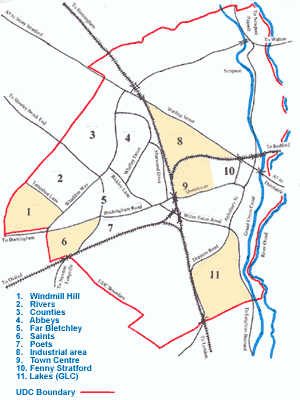

As Bletchley was a leading authority in post war housing, this decision was greeted with much approval and meant that the council of the day could, in effect, 'control its own destiny'. Bletchley's zeal was such that the Town Development Act of 1952 was backdated to cover the work that had begun in Bletchley prior to the Act being confirmed by Parliament.
An important figure in Bletchley's expansion was Mr. John F. Smithie OBE who began as the Council surveyor and completed his career as Town Manager. He arrived in Bletchley in December 1944 and was immediately engrossed in post-war housing - which began with the Chestnut and Larch Grove estates. Bletchley had worked hard at developing this and had been selected to assist London in providing for the City's population.
Many discussions took place between the Ministry for Town and Country Planning and Bletchley Urban District Council, but progress was slow...

Nevertheless, by 1950, Bletchley was planning its own future as an expanded town, although on a smaller scale than under the Greater London Plan. Eventually London agreed to the new scheme and in March 1951, Buckinghamshire County Council authorised Bletchley's Town Map and Development Plan and work on housing soon began. Bletchley's councillors considered expansion to be an 'adventure' and in 1952 the Urban District Council's Development Committee said, 'We shall be taking part in one of the greatest social experiments of our time, helping to improve the lot of thousands of Londoners, whilst at the same time building up the structure of our town to a size that can provide and support many additional amenities our townsfolk have sought.'
Initially, five outer London Boroughs entered into agreements with Bletchley Urban District Council. Companies which had their factories bombed during the war or were made obsolete were encouraged to move to Bletchley. This was met with a great deal of scepticism amongst the employees and many a night Mr. Smithie addressed meetings to answer their queries and worries.
The first 'overspill' estate to be completed was the Saints and the very first Londoners - Mr. and Mrs. Arthur Attwell - moved in. Further estates were built - the Counties, Rivers, Castles and Abbeys and, in the late 1960's early 1970's came the Lakes Estate.
Bletchley underwent many changes - providing for the needs of a greater population meant growth in more areas than just housing.
The story of Bletchley's expansion and how it affected various aspects of the town is told through the pages of this website.
